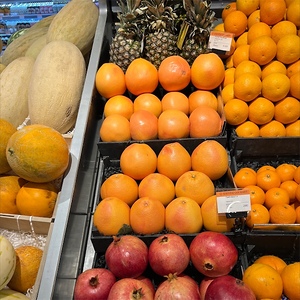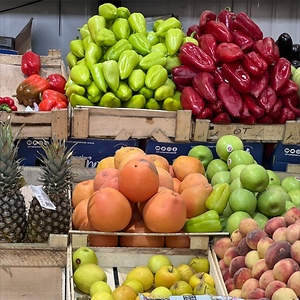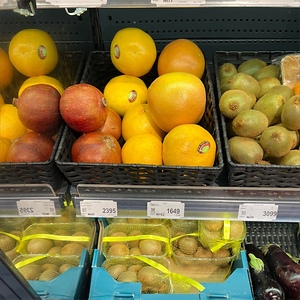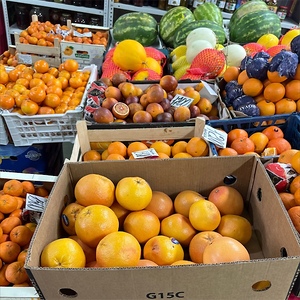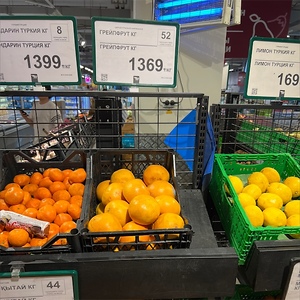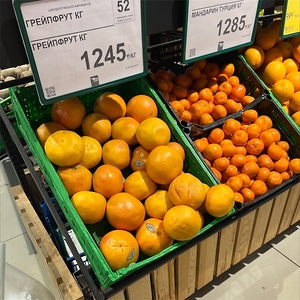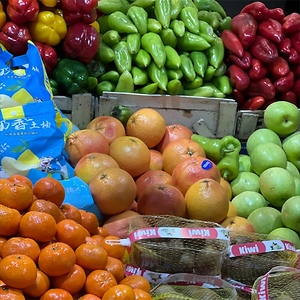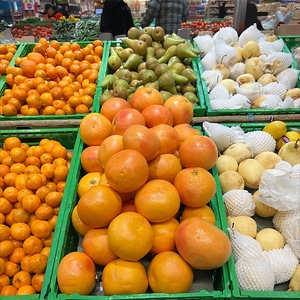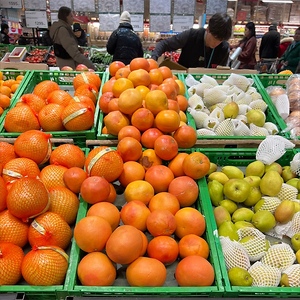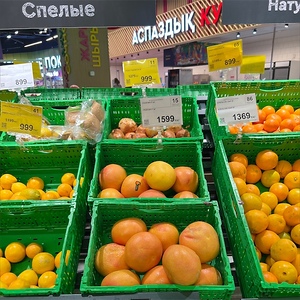


South African Grapefruit
Estimated Inventory, lb : 0
Description/Taste
South African grapefruits vary in size, appearance, and flavor, depending on the variety. Several types of grapefruit are generally sold under the collective name, and these varieties range in size from 8 to 15 centimeters in diameter. South African grapefruits are round, ovate, and oblate in shape with a curved nature, and the peel is semi-smooth, taut, and glossy with a light, pebbled feel. The surface is covered in sunken oil glands that release aromatic oils when zested, squeezed, or touched, and the fruits ripen to variegated shades of pale yellow, golden yellow, and orange blushed with red-pink spots. Underneath the peel, a layer of white, spongy pith is tightly adhered to the flesh. The red, pink, or yellow flesh is divided into 10 to 14 sections by thick membranes and is comprised of large juice vesicles. The flesh has an aqueous, tender, and succulent consistency and can be seedless or seeded. Depending on the variety and growing conditions, the flesh's core may also appear hollow or solid. South African grapefruits have a subtle, floral, and fruity fragrance and showcase varying flavors with bright, sweet, tart, tangy, acidic, sweet, and mildly bitter nuances.
Seasons/Availability
South African grapefruits are available in the fall through winter. Since the fruits are grown in the Southern Hemisphere, which has an opposite season from the Northern Hemisphere, the peak season occurs between March and September, sometimes extending into October.
Current Facts
South African grapefruits, botanically classified as Citrus paradisi, are a category of commercial cultivars belonging to the Rutaceae or citrus family. Grapefruits were introduced to South Africa sometime in the mid-19th and early 20th centuries and were established as a commercial citrus crop primarily for export. Several varieties are grown throughout the country in the present day, including Star Ruby, Marsh, Redheart, Rose, Pomelit, and Jackson. In 2024, Star Ruby grapefruits accounted for around 88% of the total production, followed by Marsh grapefruits at around 10%. South African grapefruits are only consumed on a small scale domestically as fresh fruit. Other portions of the commercial crop are processed into juices and concentrates or exported to countries worldwide.
Nutritional Value
South African grapefruits vary in vitamin and mineral content, depending on the specific variety. Grapefruits, in general, are a source of vitamins A, B6, C, and E to strengthen the immune system, maintain healthy organs, guard the cells against free radical damage, and assist in keeping the nervous system operating correctly. Grapefruits also provide fiber, which helps cleanse the digestive tract, potassium to balance fluid levels within the body, and magnesium to control nerve functions. Other nutrients include thiamine, calcium, iron, phosphorus, and folate. Some grapefruit varieties contain lycopene and anthocyanins, which give the flesh its characteristic pink-red hue. Both lycopene and anthocyanins are antioxidants to reduce inflammation and support overall bodily health. Grapefruits also provide flavonoids, including naringin, rutin, and hesperidin, to help with brain health and the fight against oxidative stress in the body.
Applications
South African grapefruits have a sweet, tart, and tangy flavor suited for fresh and cooked preparations. Grapefruits are consumed worldwide as fresh fruit. Each variety will have varying degrees of flavor, and some may be sweeter than others. South African grapefruits are popularly sliced in half and eaten with a spoon. The flesh can also be segmented and tossed into green salads or gently sliced and mixed into raw side dishes with vegetables, herbs, and cheese. Try incorporating grapefruit into fruit salads for a bright, tangy element. Grapefruit can also be added to ceviche, layered on skewers as an appetizer, or used as an acidic addition to seafood dishes like scallops. The fruit’s tart flavor complements oatmeal, chia seed pudding, and pancakes as a fresh topping, and the juice can be used to flavor healthy snacks like homemade energy bars. Beyond consuming the fruits out of hand, grapefruit juice is added to matcha beverages, lemonades, smoothies, mocktails, and cocktails. South African grapefruits are also commonly simmered into marmalades and sauces or added to fillings for baked goods like tarts, cakes, and pastries. In addition to sweet preparations, South African grapefruits can be halved and grilled for a caramelized layer or incorporated into savory dishes with roasted meats. Grapefruits can also be pickled for extended use. South African grapefruits pair well with fruits such as strawberries, mangoes, blueberries, and apricots, ginger, lavender, jasmine, basil, thyme, and mint.
Ethnic/Cultural Info
South African grapefruits are famous as an exported fruit. Citrus exports began in the early 20th century in South Africa and were initially controlled by a single export entity known as the South African Cooperative Citrus Exchange from the 1940s through the mid-1990s. Later, in 1996, new legislation was passed to open exports through multiple outlets. Grapefruits were frequently exported to the Middle East in the 1970s and were later shipped to countries in Asia, Europe, and North America. South African grapefruits were valued in the Northern Hemisphere as they had an opposite season to northern producers. Exporting South African grapefruits into the Northern Hemisphere allowed markets to have grapefruits year-round, and this is still one of the primary purposes behind grapefruit cultivation in South Africa in the modern day. In 2024, South African grapefruits were notably exported to China, the Netherlands, Japan, Russia, the United States, the United Kingdom, and the United Arab Emirates. Approximately 82% of the exported fruits are shipped through the port of Durban, while the remaining amounts are sent through the Port of Cape Town. Outside of international exports, a portion of the South African grapefruit production is processed into juices, concentrates, and grapefruit oil, which is used as a flavoring agent.
Geography/History
South African grapefruits are grown throughout the Republic of South Africa. Most of these varieties were originally developed in other countries and were planted in South African orchards sometime in the mid-19th to early 20th centuries. The two most famous cultivars, Star Ruby and Marsh, were created in the United States. Marsh grapefruits were planted in South Africa in the early 1900s, while Star Ruby was sent to South Africa in 1972. Since their establishment, South African grapefruits have been primarily grown for export to countries in the Northern Hemisphere. The export industry was thriving by 1929, and in the 1960s, South Africa became one of the top citrus exporters worldwide. This ranking has decreased over time, but South African grapefruits are still shipped worldwide as specialty citrus. Today, South African grapefruits are centralized in production in the Limpopo province of South Africa. They are also grown in Mpumalanga, KwaZulu-Natal, and the Northern Cape. When in season, South African grapefruits are sold domestically in local markets and exported internationally to select retailers and distributors.



